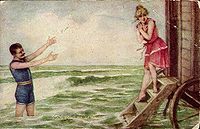Modesty: Difference between revisions
Enthusiast01 (talk | contribs) |
Enthusiast01 (talk | contribs) |
||
| Line 102: | Line 102: | ||
Around 1913, it became fashionable for dresses to be worn with a modest round or V-shaped neckline. In the [[German Empire]], for example, all [[Roman Catholic]] bishops joined in issuing a pastoral letter attacking the new fashions.<ref>Gernsheim, Alison. ''Victorian and Edwardian Fashion. A Photographic Survey''. Mineola, N.Y.: Dover Publications, 1981. Reprint of 1963 edition. ISBN 0-486-24205-6, p. 94</ref> As a result, fashions became more restrained in terms of [[décolletage]], while exposure of the leg became more accepted in Western societies, during [[World War I]] and remained so for nearly half a century.<ref>Johnson, Kim K. P.; Torntore, Susan J. and Eicher, Joanne Bubolz. ''Fashion foundations'', p. 716, Berg Publishers, 2003, ISBN 1-85973-619-X</ref> |
Around 1913, it became fashionable for dresses to be worn with a modest round or V-shaped neckline. In the [[German Empire]], for example, all [[Roman Catholic]] bishops joined in issuing a pastoral letter attacking the new fashions.<ref>Gernsheim, Alison. ''Victorian and Edwardian Fashion. A Photographic Survey''. Mineola, N.Y.: Dover Publications, 1981. Reprint of 1963 edition. ISBN 0-486-24205-6, p. 94</ref> As a result, fashions became more restrained in terms of [[décolletage]], while exposure of the leg became more accepted in Western societies, during [[World War I]] and remained so for nearly half a century.<ref>Johnson, Kim K. P.; Torntore, Susan J. and Eicher, Joanne Bubolz. ''Fashion foundations'', p. 716, Berg Publishers, 2003, ISBN 1-85973-619-X</ref> |
||
The Catholic-inspired [[Legion of Decency]] has been active from the 1930s in monitoring social morality in films. It has condemned a number of films including those that have displayed [[cleavage (breasts)|cleavage]], such those in the 1941 film ''[[The Outlaw]]'' and also in the 1953 film ''[[The French Line]]''. Both films were [[list of films condemned by the Legion of Decency|condemned by the Legion]]. |
|||
====Church of Jesus Christ of Latter-day Saints==== |
====Church of Jesus Christ of Latter-day Saints==== |
||
Revision as of 06:54, 9 September 2012
This article needs additional citations for verification. (July 2012) |


Modesty and modest have two rather different meanings. The word is used as an antonym of boastfulness; a modest person does not draw attention to their own real or supposed accomplishments and desirable attributes. Terms related to "modesty" in this sense include "humility", "shyness", and "simplicity". A related usage is for some object or attribute that is, in actual fact, not very desirable; a "modest dwelling" would describe a hut, but not a palace.
The word is also used, more about women than men, to describe a mode of dress and deportment intended not to encourage the opposite sex; actual standards vary widely. Clothing should not reveal parts of the body that society of the time and place consider immodest. A modest women would not behave so as to encourage the sexual attention of men. In some societies women must cover their bodies completely, viewing the world through a cloth grille, and may never talk to men who are not immediate family members; in others a fairly revealing but one-piece bathing costume is considered modest when other women wear bikinis. Modesty in dress and deportment is usually encouraged by peer pressure, although a few countries enforce rigid dress codes. Most societies enforce some degree of modesty; public nudity is generally illegal in most of the world. Even nudity is tolerated exceptionally in some societies at some times; a world naked bike ride was organised and accepted to encourage cycling[1], while a lone man attempting to walk naked from south to north Britain was repeatedly imprisoned[2].
Small children generally start being partially or totally exempt from adult requirements of modesty, with requirements increasing as they grow up.
In semi-public contexts standards of modesty vary. Nudity may be acceptable in public single-sex changing rooms at swimming baths, for example, or for mass medical examination of men for military service.
In private, standards again depend upon the circumstances. A person who would never disrobe in the presence of a physician of the opposite sex in a social context might unquestioningly do so for a medical examination; others might allow examination, but only by a person of the same sex.
Necessity
At times of public or private emergency, expectations of modest dress may be suspended if necessary. For example, during suspected anthrax attacks in 1998 and 2001 in the United States, groups of people had to strip to their underwear in tents set up in parking lots and other public places for hosing down by fire departments.[3] On the other hand, even in an emergency situation, some people are unable to abandon their need to hide their bodies, even at the risk of their life[3]. This may apply to decontamination after a chemical or biological attack, where removal of contaminated clothing is vital, or escaping from a night-time fire without time to dress.
Body modesty

Standards of modesty discourage or forbid exposure of parts of the body, varying between societies, which may include areas of skin, the hair, undergarments, and especially intimate parts. The standards may also require obscuring the shape of the body or parts of it by wearing non-form-fitting clothing. There are also customs regarding the changing of clothes (such as on a beach with no enclosed facilities), and the closing or locking of the door when changing or taking a shower.
Standards of modesty vary by culture or generation and vary depending on who is exposed, which parts of the body are exposed, the duration of the exposure, the context, and other variables. The categories of persons who could see another's body could include:
- a spouse or partner,
- a friend or family member of the same sex,
- strangers of the same sex,
- people of the same social class.
The context would include matters such as whether it is in one's own home, at another family member's home, at a friend's home, at a semi-public place, at a beach, swimming pool (including whether such venues are considered clothes-optional), changing rooms or other public places. For instance, wearing a bathing suit at the beach would not be considered immodest, while it likely would be in a street or an office.
Excessive modesty is called prudishness. As a medical condition, it is also called gymnophobia. Excessive immodesty is called exhibitionism.
Proponents of modesty often see it as a demonstration of respect for their bodies, for social norms, and for the feelings of themselves and others. Some critics assert that modesty reflects a negative body image and that there may be a correlation between repressive body attitudes and undesirable outcomes such as sexual crimes, violence, and stress.[4]
Modesty in dress

Most discussion of modesty involves clothing. The criteria for acceptable modesty and decency have relaxed continuously in much of the world since the nineteenth century, with shorter, form-fitting, and more revealing clothing and swimsuits, more for women than men. Most people wear clothes that they consider not to be unacceptably immodest for their religion, culture, generation, occasion, and the people present. Some wear clothes which they consider immodest, due to exhibitionism, the desire to create an erotic impact, or for publicity.
Generally-accepted Western norms
This section needs additional citations for verification. (August 2012) |
As a minimum, Western standards of decency expect people to cover their genitalia in public, and women to cover their breasts. In the early twentyfirst century public breastfeeding became increasingly but not totally acceptable, sometimes protected by law.
What is considered appropriate depends on context. For example, in single-sex public changing rooms nudity is often acceptable.
In Western and some other societies, there are differences of opinion as to how much body exposure is acceptable in public.[5] In contemporary Western society, the extent to which a woman may expose cleavage depends on social and cultural context. Women's swimsuits and bikinis commonly reveal the tops and sides of the breasts. Displaying cleavage is considered permissible in many settings, and is even a sign of elegance and sophistication on many formal social occasions, but it may be considered inappropriate in settings such as workplaces, churches and schools. Showing the nipples or areolae is almost always considered toplessness or partial nudity.
In private homes, the standards of modesty apply selectively. For instance, nudity among close family members in the home can take place, especially in the bedroom and bathroom, and wearing of undergarments only in the home is common.
In many cultures it is not acceptable to bare the buttocks in public; deliberately doing so is sometimes intended as an insult.
Gender differences
Men and women are subject to different standards of modesty in dress. While both men and women, in Western culture, are generally expected to keep their genitals covered at all times, women are also expected to keep their breasts covered. Some body parts are normally more covered by men than women, e.g. the midriff and the upper part of the back. Organizations such as the Topfree Equal Rights Association advocate for gender equality regarding display of the body. In 1992 New York State's highest court accepted 14th Amendment arguments and struck down the provision in New York's Exposure of the Person statute that made it illegal for women to bare their chests where men were permitted to do so.[6]
Naturism
Naturists or nudists reject contemporary Western standards of modesty which discourage personal, family, and social nudity, and seek to create a social environment where people feel comfortable in the company of nude people, and being seen in the nude, either just by other nudists, or also by the general public.[7][8]
Traditional indigenous modesty
Traditional indigenous cultures, such as some African and traditional Australian aboriginal cultures, are more relaxed on issues of clothing, though how much clothing is expected varies greatly, from nothing for some women, to everything except the glans penis for men of some tribes. In some African cultures, body painting is considered to be body coverage, and is considered by many an attire.
Religious traditions of modesty
Most world religions have sought to address the moral issues that arise from people's sexuality in society and in human interactions. Each major religion has developed moral codes covering issues of sexuality, morality, ethics etc. Besides other aspects of sexuality, these moral codes seek to regulate the situations which can give rise to sexual interest and to influence people's behaviour and practices which could arouse such interest, or which overstate a person's sexuality. These religious codes have always had a strong influence on peoples' attitudes to issues of modesty in dress, behavior, speech etc.
Islamic modesty

Modesty has been and continues to be considered important in Islamic society, but the interpretation of what clothing is considered modest varies. The holy book of Islam, the Qur'an states that women should dress modestly in the presence of men who are not family members, but does not require wearing of the hijab or similar garments.
Women
One traditional opinion is that Muslim women are required to wear the hijab, covering everything but the hands and face, as a sign of modesty. Some Muslims are of the opinion that modesty is not restricted to dress but also depends on the intentions of the individual. In some Muslim societies, women wear the niqab, a veil that covers the whole face except the eyes, or the full burqa, a full-body covering garment that occasionally does cover the eyes. Wearing these garments is common in some, but not all, countries with a predominantly Muslim population.

Though by some scholars these expressions of modesty are interpreted as mandatory, most countries do not enforce modesty by law. However, a few countries, such as Saudi Arabia, Afghanistan and Iran, enforce specified standards of dress for women.
Men
Men are required to cover everything from 'navel to knee'; some men choose also to wear the traditional Islamic cap (taqiyah), similar to but larger than the Jewish yarmulke or kippah. The taqiyah may vary in shape, size and color, with differences according to tradition, region, and personal taste.
Jewish modesty

Modesty in Judaism, called Tzniut, is important beyond aspects of clothing. It extends to behaviour in public and in private, and depends on the context.
Women
Orthodox and ultra-Orthodox Jewish women usually wear skirts to their knees and to cover their elbows, with blouses covering the collarbone and sleeves coming to or covering elbows.[9] See-through materials may not be used and clothes are expected not to be tight-fitting, provocative, loud in color, or display texts.[10] These rules are relaxed to allow for color and text in less strict communities. Some modern Orthodox communities allow the collarbone to be shown (so long as cleavage is amply covered), and sleeves not to reach the elbow. There are many different opinions on these issues. Some communities apply these standards to girls as young as three. Less strict Conservative Judaism recommends modest dress, but this is not broadly observed. Less restrictive branches of Judaism tend to adopt the fashions of the society in which they live.
It is the custom for an observant married Orthodox Jewish woman to cover her hair in public, and sometimes at home. The hair covering may be a scarf, hat, snood called a Tichel, or a wig called a Sheitel.
Women who do not follow all the regulations in everyday life, often do so during religious observances in a synagogue or elsewhere.
Men
Standards of modesty also apply to men. While some men will wear shorts and short-sleeve shirts, many strictly observant Orthodox men will not. Additionally, men are required to cover the crown of their head (although not for reasons of modesty as such, but as a required observance) and they traditionally do so with kippot and, in some cases, a hat.[9] Less religious men do not cover their heads in everyday life, but do so during religious observances in a synagogue or elsewhere.
Christian modesty
Catholic Church

Catholics are expected to dress modestly; it is recognised that the forms taken by modesty vary from one culture to another.[11] The wearing of a headcovering was for the first time mandated as a universal rule for the Latin Rite by the Code of Canon Law of 1917[12], abrogated by the 1983 Code of Canon Law.[13] Apart from that, there have never been any "official" guidelines issued by the Catholic Church. But from time to time the Church hierarchy, and some popes, have given opinions on various matters; although these guidelines are not binding, they are often followed.[14] Pope Pius XII stated that women should cover their upper arms and shoulders, that their skirts should cover at least as far as the knee, and the neckline should not reveal anything.[15] Giuseppe Cardinal Siri of Genoa stated that trousers were unacceptable dress for women.[16] Many traditional Catholics have attempted to further expand on this latter standard.[17]
Some Catholics have attempted to form cohesive theories of modesty. Sometimes this is from a sociological perspective,[15] while at other times it takes a more systematic, Thomistic approach, combined with the writings of the Church Fathers.[18] Approaches arguing primarily from traditional practices and traditional authorities, such as the saints, can also be found.[19]
Around 1913, it became fashionable for dresses to be worn with a modest round or V-shaped neckline. In the German Empire, for example, all Roman Catholic bishops joined in issuing a pastoral letter attacking the new fashions.[20] As a result, fashions became more restrained in terms of décolletage, while exposure of the leg became more accepted in Western societies, during World War I and remained so for nearly half a century.[21]
The Catholic-inspired Legion of Decency has been active from the 1930s in monitoring social morality in films. It has condemned a number of films including those that have displayed cleavage, such those in the 1941 film The Outlaw and also in the 1953 film The French Line. Both films were condemned by the Legion.
Church of Jesus Christ of Latter-day Saints
The Church of Jesus Christ of Latter-day Saints (LDS Church) has issued official statements on modest dress for its members. Clothing which can stimulate sexual desires, such as "short shorts and skirts, tight clothing, and shirts that do not cover the stomach"[22] are discouraged. Men and women are also encouraged to avoid extremes in clothing or hairstyles. Rules on modesty also include women being asked to wear no more than one pair of earrings.[22] Women are generally expected to wear skirts or dresses for church services. Most LDS do not wear sleeveless shirts or shorts that do not reach the knee.
The Church requires students of Brigham Young University (BYU), its private university, and tenants of BYU housing, to sign an agreement to live according to these standards of modesty.[23]
Other Churches
Many other Trinitarian Christians also consider modesty extremely important,[24] though considerable differences of opinion exist about its requirements and purposes.[25] Amish groups and some Mennonite groups are known for their adherence to modest fashion styles. Evangelical Christians and Holiness Christians also have strict guidelines on modesty.
Cross-cultural and non-religious modesty
Some individuals adopt modesty standards of other groups or standards of previous generations.[26] An example includes the Noahides who follow Jewish laws but are not themselves Jewish.
Modesty in the arts

Standards of modesty in art have varied at different times and in different places. Nudity and various types of behaviour were sometimes depicted, sometime not. In many cases where society did not allow nudity or immodest dress, nudity was accepted in art. Where nudity in art was not acceptable, full nudity was not displayed; otherwise nude subjects had their private parts hidden by apparently accidental draped fabric, flowers, other people, a fig leaf, etc. In films, very brief nudity was accepted. Some nude artworks had fig leaves added when standards became less permissive.
In a given society, the criteria varied according to the circumstances; for example artworks on public display were more restrained than those for private display to adults.
Nudity in art was sometimes suggested without actual depiction by:
- something seemingly by chance covering the private parts
- in film:
- showing a supposedly nude person from the waist or shoulders up
- maneuvering (turning, having objects in front) and editing in such a way that no genitals are seen
- showing nudity from a distance, or from the back only, although other characters are nearby and/or would also see frontal nudity
- showing nudity very briefly
In cartoons, even in cases where the genital area is not covered with clothing, genitals are often simply not drawn. In the film Barnyard, showing anthropomorphized cattle of both sexes walking on two legs, instead of either showing genitals of male cattle or not showing them, the concept of a "male cow" was used, with an udder. In Underdog a partly animated anthropomorphized dog is shown with penis when a real dog is filmed, and without penis in the animated parts.
Paintings are sometimes changed because of changed modesty standards, and later sometimes changed back, see Expulsion from the Garden of Eden, Fig leaf.
See also
- Evolution of morality
- Exhibitionism
- Indecent exposure
- Sex segregation
- SlutWalk
- Topfree equality
- Tzniut
Footnotes
- ^ Guardian newspaper: World Naked Bike Ride – in pictures, 10 June 2012 While most of the riders are naked, all the photographs in this series obscure details by strategically places handlebars.
- ^ Guardian newspaper: Naked rambler vows to walk on, 26 August 2003
- ^ a b We'd rather die than take our clothes off, disaster planners say, By Dru Sefton, Newhouse News Service, Nation & World: Saturday, May 25, 2002
- ^ http://www.onlineopinion.com.au/view.asp?article=4845
- ^ Salmansohn, Karen. "The Power of Cleavage". The Huffington Post, October 29, 2007.
- ^ Santorelli & Schloss v. State of New York
- ^ See 2002-2003 World Naturist Handbook, pub International Naturist Federation INF-FNI, Sint Hubertusstraat, B-2600 Berchem(Antwerpen) ISBN 90-5583-833-0 The Agde definition. The INF is made up of representative of the Naturist Organizations in 32 countries, with 7 more having correspondent status. The current edition is * Naturisme, The INF World Handbook (2006) [1] ISBN 90-5062-080-9
- ^ http://www.inf-fni.org/index_e.htm%7C INF web page
- ^ a b "Modesty: Not Only A Woman's Burden", Patheos
- ^ The Laws of Jewish Modesty [dead link]
- ^ See, e.g., [2] Para. 2521-2524.
- ^ "1917 Codex Iuris Canonici". Canon 1262, Section 2. (Latin)
- ^ "Canon 6 §1 of the Code of Canon Law".
- ^ See all the following citations, which all expound at least partly upon such guidelines.
- ^ a b Modesty and beauty - the lost connection by Regina Schmiedicke
- ^ Notification Concerning Men's Dress Worn by Women by Giuseppe Cardinal Siri (1960)
- ^ See G. K. Chesterton, What's Wrong with the World, Part III, Chap. V, for an early attempt (1910); see also In Praise of the Skirt, for a more contemporary one (2006)
- ^ The Modesty Handbook (describing the nature of modesty from a Catholic perspective, based on St. Thomas Aquinas and the Church Fathers).
- ^ See, e.g., Those Who Serve God Should Not Follow the Fashions by Robert T. Hart (2004).
- ^ Gernsheim, Alison. Victorian and Edwardian Fashion. A Photographic Survey. Mineola, N.Y.: Dover Publications, 1981. Reprint of 1963 edition. ISBN 0-486-24205-6, p. 94
- ^ Johnson, Kim K. P.; Torntore, Susan J. and Eicher, Joanne Bubolz. Fashion foundations, p. 716, Berg Publishers, 2003, ISBN 1-85973-619-X
- ^ a b Mormon modesty guidelines
- ^ The Brigham Young University Honor Code, which includes "Dress and Grooming Standards," agreement to which is required for application.
- ^ See, e.g., Modesty: The Undressing of Our Youth, by Lenora Hammond.
- ^ The Modesty Survey: An anonymous discussion among Christians concerning various aspects of modesty.
- ^ http://canadianundercover.wordpress.com/about/ Canadian Undercover
